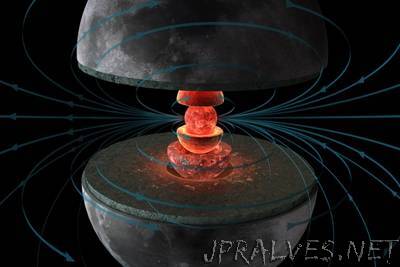
“New evidence from ancient lunar rocks suggests that an active dynamo once churned within the molten metallic core of the moon, generating a magnetic field that lasted at least 1 billion years longer than previously thought. Dynamos are natural generators of magnetic fields around terrestrial bodies, and are powered by the churning of conducting fluids within many stars and planets. In a paper published today in Science Advances, researchers from MIT and Rutgers University report that a lunar rock collected by NASA’s Apollo 15 mission exhibits signs that it formed 1 to 2.5 billion years ago in the presence of a relatively weak magnetic field of about 5 microtesla. That’s around 10 times weaker than Earth’s current magnetic field but still 1,000 times larger than fields in interplanetary space today. Several years ago, the same researchers identified 4-billion-year-old lunar rocks that formed under a much stronger field of about 100 microtesla, and they determined that the strength of this field dropped off precipitously around 3 billion years ago. At the time, the researchers were unsure whether the moon’s dynamo — the related magnetic field — died out shortly thereafter or lingered in a weakened state before dissipating completely. The results reported today support the latter scenario: After the moon’s magnetic field dwindled, it nonetheless persisted for at least another billion years, existing for a total of at least 2 billion years. Study co-author Benjamin Weiss, professor of planetary sciences in MIT’s Department of Earth, Atmospheric and Planetary Sciences (EAPS), says this new extended lifetime helps to pinpoint the phenomena that powered the moon’s dynamo. Specifically, the results raise the possibility of two different mechanisms — one that may have driven an earlier, much stronger dynamo, and a second that kept the moon’s core simmering at a much slower boil toward the end of its lifetime.”
